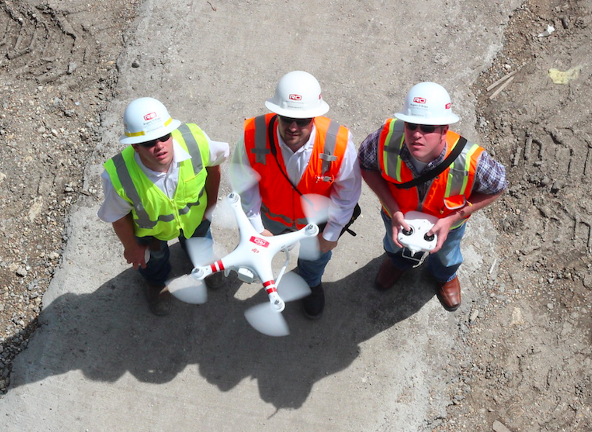DroneDeploy shares lessons learned from helping companies large and small get their drone programs off the ground. “2017 was a banner year for drones. It probably seems like every time you turn around, a new company in your industry has gotten into the UAV game. And for good reason. Drone mapping delivers an average of three times cost and time savings compared to traditional methods of data capture. With results like this, chances are you’re thinking about getting into the action by building a drone program at your company.
“But if you are going to do this, you should do it right. And you’ve probably got some questions before you begin. Where do I start? What should I consider? What are the risks? To jumpstart your UAV journey, and get the rest of the company on board, here are five things to consider before you set up an in-house drone operation.
- Create Corporate Buy-in with a Clear Plan of Adoption
You may already know that drones increase efficiency, drive down costs, and increase ROI, but what about your top execs? No matter how jazzed you are about drones, it doesn’t mean anything if you can’t convince corporate to back your efforts.
As you work to create executive buy-in, be prepared to meet with skepticism and obstacles. Your goal is to answer their questions before they get a chance to ask them. To minimize pushback, come in with a thorough, thoughtful plan of action right out of the gate.
Elements to include in your drone program plan of adoption:
- Start small with a proof of concept
- Identify immediate opportunities with the highest rate of return
- Focus on business outcomes, not just the exciting technology
- Develop metrics to measure success
- Include a data management plan
- Gather input from key stakeholders
- Understand The Regulations
Commercial drone legislation introduced around the world has made it easier than ever to integrate UAVs into your operations, but there are still licensing and airspace regulations that must be followed. You’ll save yourself a lot of headache — and calls from legal — if you take time to understand them.
Familiarize yourself with the regulatory framework for flying drones commercially in your part of the world. If you are in the US, you’ll need to consult the FAA’s Part 107 regulations and accompanying pilot certification requirements.
To learn more about pilot certification and airspace regulations, download DroneDeploy’s full eBook on setting up a drone operation.
- Build a Strong Drone Team
You might start with just one drone at a single job site, but chances are, your program won’t stay that small for long. When it comes time to scale up, avoid growing pains by building a solid drone team and establishing clear roles and responsibilities.
Here are some of the key roles we often see our customers hiring for when launching their programs:
Chief Pilot and UAV Operations Coordinator: This role oversees setup, develops strategy, and manages the program. While you may choose to contract out other team positions, we recommend hiring an in-house person to lead your program.
Pilots: Pilots can be contracted out or hired in-house. They are responsible for collecting drone data in the field and providing deliverables to the team. Our eBook includes an in-depth discussion about contracting out or hiring in-house drone pilots.
Drone Data Analyst: You’ll need someone to manage and analyze your data to generate insights and make discoveries. This should be an in-house employee — someone familiar with your industry challenges and able to assist the team by putting all this data to work.
DARTdrones will train your team and provide ongoing consultation.
- Minimize Risk with Insurance, Training, and Safety Procedures
There is a lot on the line with incorporating drones into the workplace. You’ll need to take the necessary steps to ensure you are minimizing that risk and doing everything to support a safe environment for the program to thrive.
Establish written safety protocols. To increase buy in for these protocols, make sure they are simple and repeatable. Educate employees about the potential risks of flying drones and make sure employees at all levels of the company are on board.
Purchase adequate drone insurance for your fleet. There are two basic types of insurance that you will want to consider: hull and liability. Liability insurance is an absolute must. Hull insurance, usually separate from liability coverage, is especially important to consider if you are operating a more expensive system such as the DJI Inspire or Matrice series.
Invest in a training program for your team. DroneDeploy recommends working with DARTdrones, the industry’s leading training and consultation program. DARTdrones can provide custom training packages for any team.
- Do Your Homework on Drone Hardware and Software
It’s important to choose the right hardware and software solutions early on so that when the time comes to scale, you won’t have to change gears and introduce a new workflow across your team. There’s a lot to choose from, so keep these things in mind as you shop around:
- Buy a drone that supports your use case: Consider your industry, average flying conditions, and mapping subject before you buy.
- Keep budget in mind: In many cases, you don’t need the most expensive model on the market to get great results.
- Newer is usually better: Invest in the latest drone model for a longer shelf life, more software integrations, and a better user experience.
- Choose best-in-class software: To get the results you need, choose a broad, integrated technology solution like DroneDeploy. Ask about our platform’s powerful APIs, now available to enterprise customers.











